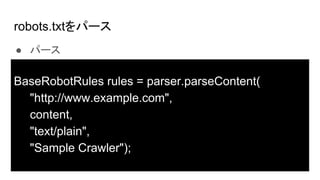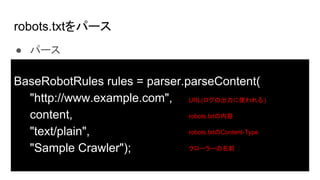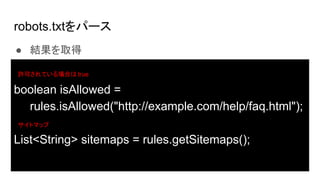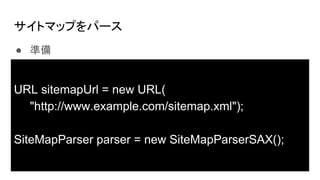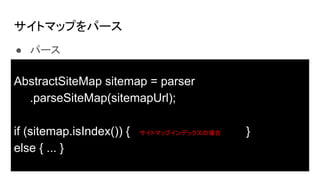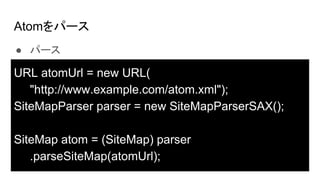Crawler Commons
- 2. Me u±Ÿ ¶àżÉŚÓŁš@chibochibo03Ł© ÖêÊœ»áÉç„Ó„ș„ê©`„Á CTOÊÒ Æն΀ÏScala€òű€€€Æ€Ț€č Apache ±Ê°ù±đ»ćŸ±łŠłÙŸ±ŽÇČÔ±ő°ż€Î„ł„ß„Ă„ż€Ë€Ê€ê€Ț€·€ż
- 3. „Ż„í©`„é©`€Ă€ÆŁż Ąń „€„ó„ż©`„Í„Ă„È€ËĐî·e€”€ì€Æ€€€ëĄ©€ÊÇéó€ò §ŒŻ€· Ąń „Ç©`„ż€È€·€Æ»îÓÀǀ€ë€è€Š€Ë€č€ë€ż€á€Î€â€Î Ąń ÇéóÌáč©€·€Æ€Ż€À€”€ëWeb„”„€„È€Ź€ą€Ă€Æ€ł€œłÉ€êÁą€Ä Ąń ĂÔ»ó€ò€«€±€Æ€·€Ț€Š€è€Š€Ê€ł€È€Ï±Ü€±€Ê€Ż€Æ€Ï€Ê€é€Ê€€
- 4. „ë©`„ë€òÊŰ€ë Ąń „Ż„í©`„뀷€Æ€â€è€€„Ú©`„žĄą„À„á€Ê„Ú©`„ž Ąđ robots.txt €Ê€É Ąń ŰșÉ€ò€«€±€ë„ą„Ż„»„č€ò€·€Ê€€ Ąđ ±ŰÒȘ€Ê„Ú©`„ž€Î€ß„Ż„í©`„ë€č€ë Ąđ „”„€„È„Ț„Ă„Ś €Ê€É Ąń Web„Ż„í©`„é©`€ËčČÍš€č€ëIÀ퀏€ą€ë
- 5. Crawler-Commons https://github.com/crawler-commons/crawler-commons Ąń Web„Ż„í©`„é€ËčČÍš€č€ëCÄÜ€ògŚ°€·€żJava„é„€„Ö„é„ê Ąđ robots.txt€Î„Ń©`„č Ąđ „”„€„È„Ț„Ă„Ś€äAtom€Î„Ń©`„č Ąđ „È„Ă„Ś„ì„Ù„ë„É„á„€„ó€ò·”€čURL„ą„Ê„é„€„¶
- 6. évßB„é„€„Ö„é„ê Ąń crawler4jĄĄJavaÓĂWeb„Ż„í©`„é©` Ąđ robots.txt€Î„Ń©`„襹„„ă„Ă„·„ć Ąö œûÖ耔€ì€Æ€€€ë„Ú©`„ž€Ï„Ż„í©`„뀷€Ê€€ Ąń jsoupĄĄJavaÓĂHTML„Ń©`„” Ąđ „Ú©`„ž€ò„Ż„í©`„뀷€ÆœâÎö€č€ë Ąö Ô”±„Ú©`„ž€ŹÔSżÉ€”€ì€Æ€€€ë€«€É€Š€«€ÏŚÔ·Ö€ÇĆжš€č€ë
- 8. robots.txt€ò„Ń©`„č Ąń Êä byte[] content = ... robots.txt€òŐi€ßȚz€à ... SimpleRobotRulesParser parser = new SimpleRobotRulesParser();
- 9. robots.txt€ò„Ń©`„č Ąń „Ń©`„č BaseRobotRules rules = parser.parseContent( "http://www.example.com", content, "text/plain", "Sample Crawler");
- 10. robots.txt€ò„Ń©`„č Ąń „Ń©`„č BaseRobotRules rules = parser.parseContent( "http://www.example.com", content, "text/plain", "Sample Crawler"); URL(„í„°€ÎłöÁŠ€ËÊč€ï€ì€ë ) robots.txt€ÎÄÚÈĘ robots.txt€ÎContent-Type „Ż„í©`„é©`€ÎĂûÇ°
- 11. robots.txt€ò„Ń©`„č Ąń œYčû€òÈĄ”Ă boolean isAllowed = rules.isAllowed("http://example.com/help/faq.html"); List<String> sitemaps = rules.getSitemaps(); ÔSżÉ€”€ì€Æ€€€ëöșÏ€Ï true „”„€„È„Ț„Ă„Ś
- 12. „”„€„È„Ț„Ă„Ś€ò„Ń©`„č Ąń Êä URL sitemapUrl = new URL( "http://www.example.com/sitemap.xml"); SiteMapParser parser = new SiteMapParserSAX();
- 13. „”„€„È„Ț„Ă„Ś€ò„Ń©`„č Ąń „Ń©`„č AbstractSiteMap sitemap = parser .parseSiteMap(sitemapUrl); if (sitemap.isIndex()) { } else { ... } „”„€„È„Ț„Ă„Ś„€„ó„Ç„Ă„Ż„č€ÎöșÏ
- 14. „”„€„È„Ț„Ă„Ś€ò„Ń©`„č Ąń „”„€„È„Ț„Ă„Ś„€„ó„Ç„Ă„Ż„č SiteMapIndex smIndex = (SiteMapIndex) sitemap; for (AbstractSiteMap sm : smIndex.getSitemaps()) { URL url = sm.getUrl(); ... } (Àę) http://www.example.com/sitemap1.xml.gz
- 15. „”„€„È„Ț„Ă„Ś€ò„Ń©`„č Ąń €œ€ìÒÔÍâ SiteMap sm = (SiteMap) sitemap; for (SiteMapURL u : sm.getSiteMapUrls()) { URL url = u.getUrl(); ... } (Àę) http://www.example.com/catalog?item=1
- 16. Atom€ò„Ń©`„č Ąń „Ń©`„č URL atomUrl = new URL( "http://www.example.com/atom.xml"); SiteMapParser parser = new SiteMapParserSAX(); SiteMap atom = (SiteMap) parser .parseSiteMap(atomUrl);
- 18. TLD€òÈĄ”Ă Ąń ÈĄ”Ă EffectiveTLD etld = EffectiveTldFinder .getEffectiveTLD("blogs.yahoo.co.jp"); String tld = etld.getDomain(); co.jp
- 19. €Ț€È€á Ąń Web„Ż„í©`„é©`€Ë€ą€ê€Ź€Á€ÊčČÍšCÄÜ€òÌáč© Ąń robots.txtĄą„”„€„È„Ț„Ă„Ś€ÎœâÎö Ąń €ł€Š€€€Ă€ż„é„€„Ö„é„ê€ò»îÓĂ€č€ë€Î€â1€Ä€ÎÊÖ



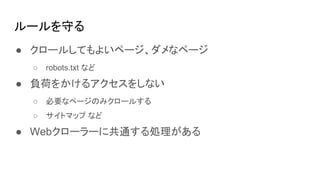
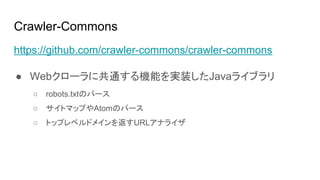
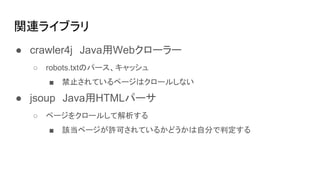
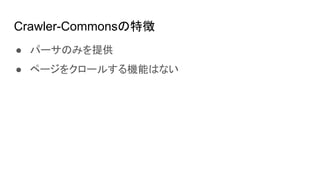
![robots.txt€ò„Ń©`„č
Ąń Êä
byte[] content = ... robots.txt€òŐi€ßȚz€à ...
SimpleRobotRulesParser parser =
new SimpleRobotRulesParser();](https://image.slidesharecdn.com/crawler-commons-171002105108/85/Crawler-Commons-8-320.jpg)
